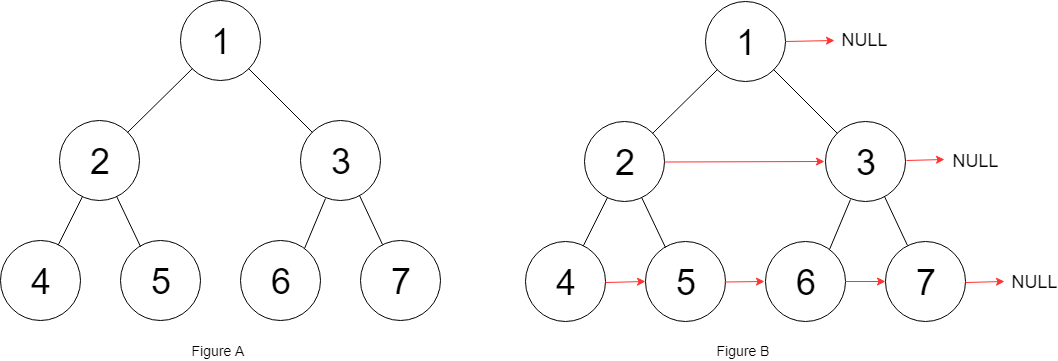# 填充每个节点的下一个右侧节点指针
给定一个 完美二叉树 ,其所有叶子节点都在同一层,每个父节点都有两个子节点。二叉树定义如下:
struct Node {
int val;
Node *left;
Node *right;
Node *next;
}
填充它的每个 next 指针,让这个指针指向其下一个右侧节点。如果找不到下一个右侧节点,则将 next 指针设置为 NULL。
初始状态下,所有 next 指针都被设置为 NULL。
进阶:
- 你只能使用常量级额外空间。
- 使用递归解题也符合要求,本题中递归程序占用的栈空间不算做额外的空间复杂度。
示例:

输入:root = [1,2,3,4,5,6,7]
输出:[1,#,2,3,#,4,5,6,7,#]
解释:给定二叉树如图 A 所示,你的函数应该填充它的每个 next 指针,以指向其下一个右侧节点,如图 B 所示。序列化的输出按层序遍历排列,同一层节点由 next 指针连接,'#' 标志着每一层的结束。
提示:
- 树中节点的数量少于
4096
-1000 <= node.val <= 1000
## template
```cpp
#include
using namespace std;
class Node
{
public:
int val;
Node *left;
Node *right;
Node *next;
Node() : val(0), left(NULL), right(NULL), next(NULL) {}
Node(int _val) : val(_val), left(NULL), right(NULL), next(NULL) {}
Node(int _val, Node *_left, Node *_right, Node *_next)
: val(_val), left(_left), right(_right), next(_next) {}
};
class Solution
{
public:
Node *connect(Node *root)
{
if (!root)
return nullptr;
root->next = nullptr;
connect_helper(root);
return root;
}
private:
void connect_helper(Node *pNode)
{
if (!pNode)
return;
if (pNode->left == nullptr)
return;
pNode->left->next = pNode->right;
if (pNode->right == nullptr)
return;
if (pNode->next != nullptr)
pNode->right->next = pNode->next->left;
else
pNode->right->next = nullptr;
connect_helper(pNode->left);
connect_helper(pNode->right);
}
};
```
## 答案
```cpp
```
## 选项
### A
```cpp
```
### B
```cpp
```
### C
```cpp
``` 
